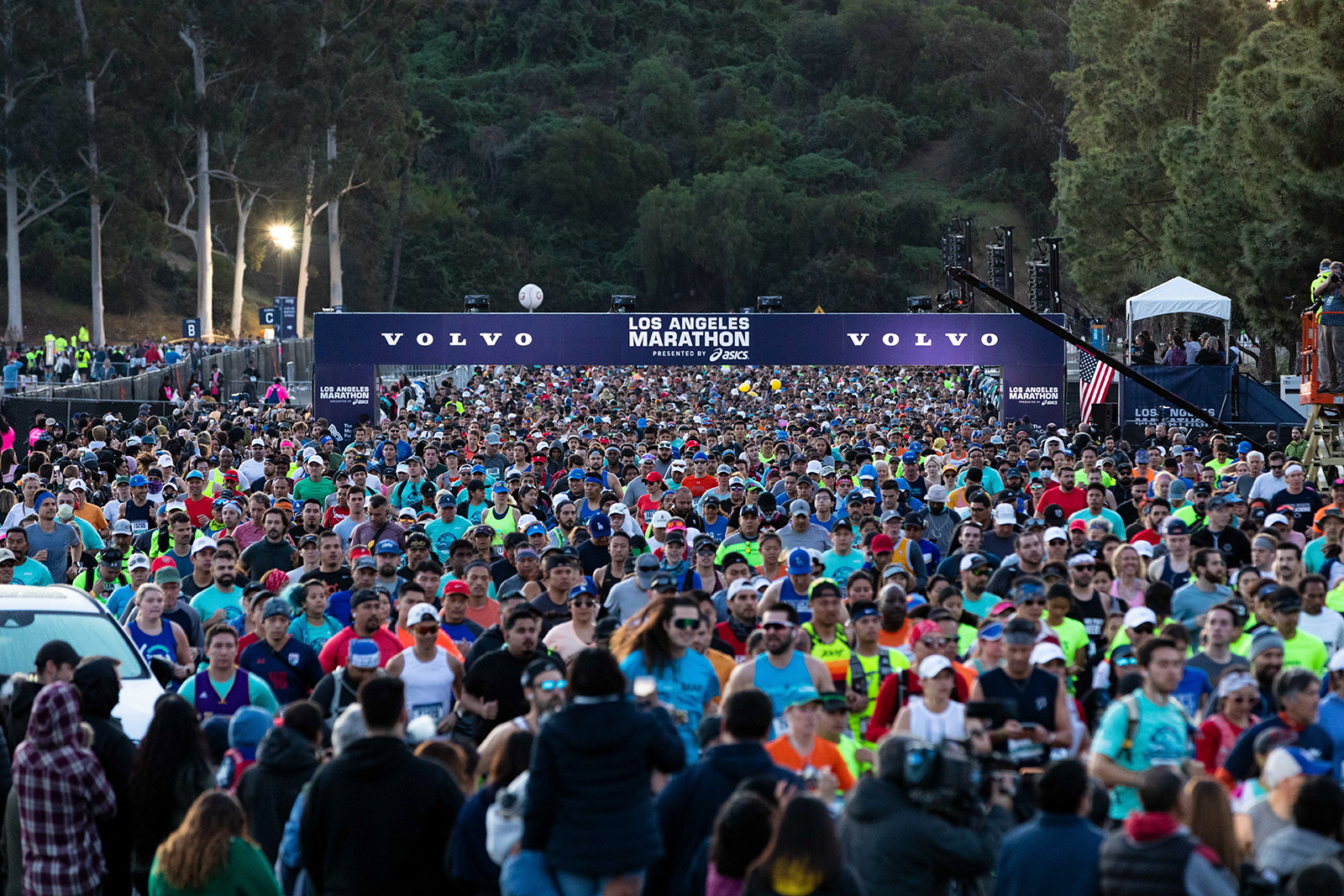UCLA students overcome obstacles to complete LA Marathon

Thousands of people begin the annual Los Angeles Marathon in the early hours of Sunday morning. Marathons are 26.2 miles long and usually take between two and six hours to complete. (Jintak Han/Daily Bruin senior staff)

By Maddie Rausa
March 8, 2020 11:29 p.m.
This post was updated March 9 at 6:01 p.m.
Around mile 20 of the Los Angeles Marathon, just as he passed through Westwood, Jason Lin felt his leg tense up from his IT band syndrome, a condition that causes swelling and pain around the knee.
Every step was difficult.
“I just kind of wanted to give up,” said Lin, a graduate student at UCLA.
His running partner, a friend from his graduate biomathematics program, kept him going, Lin said. His running partner cheered along and kept a positive attitude from start to finish. And when Lin’s partner started to feel cramps in his knees, Lin was able to encourage him in turn.
“Throughout the race we kind of just talked to each other, like, ‘Hey, we can do this,’” Lin said.
The LA Marathon took off from Dodger Stadium early this Sunday. Competing Bruins raced through iconic locations like Chinatown and Hollywood, later passing through Westwood and finishing at Santa Monica Beach.
One station at the mile 20 mark, dubbed “Rivalry Row,” even divided the course between cheering UCLA and USC supporters, forcing runners to pick a side.
A marathon measures 26.2 miles, a distance that can take between two and six hours to complete. LA’s marathon takes place annually and sees over 27,000 participants. To race, participants must be 16 or older – there are no other qualifications. Participants who are younger than 16 can participate in the race through Students Run LA, a non-profit organization that trains at-risk middle and high schools students to run a marathon.
“Even other runners are kind of intimidated by the marathon,” said Connor Jops, a fourth-year computational and systems biology student who has run the LA Marathon twice before. “People need to hold it in respect, I guess.”
Training for marathons can take months, and can sometimes demand more than the race itself.
Lin was counted among more than half of the LA Marathon competitors that ran the race as their first marathon.
He started training for long-distance running in 2019 because a friend from his program, who had also never run the marathon before, invited Lin to race with him. The most running Lin usually did before then was 15 minutes on the treadmill, he said.
His training included three faster workouts during the week, an easy run Saturdays, and a two-to-three-hour-long run Sundays.
Lin, who has to work every day on a self-directed project for his graduate program, found that running helped him build discipline.
“If you don’t really have that discipline … you’ll kind of drift apart and then procrastinate more,” he said.
Lin isn’t the only student competing in a marathon this year. Several students participated in the LA Marathon, while others are preparing for different marathons, such as the Mountains 2 Beach in May.
Tulsi Patel, a fourth-year psychobiology student, is training for the San Francisco Marathon in July.
Her training schedule varies more, with a baseline three to four runs per week all year-round and a gradual increase in volume beginning around six weeks before a race, she said. Patel also plans to run two half marathons ahead of the full marathon as part of her training.
Balancing running with other responsibilities is a constant struggle, Patel said. She sometimes takes a break from running if she gets too busy.
She wasn’t always so forgiving with herself when she had to take those breaks, though, Patel said. Before her first half marathon, Patel said she pushed herself too hard, eventually turning shin splints into a stress fracture.
Nowadays, Patel tries to avoid pressure and guilt. If she doesn’t meet her weekly goals, she allows herself to relax and focus on other responsibilities.
For runners, after so much time spent training, race day itself is an entirely different experience.
The morning of a long-distance competition is usually an early one for participants. Runners in the LA Marathon lined up under the tall trees surrounding the stadium, bibs pinned to their shirts, as early as 6:30 a.m. They began in waves, with wheelchair users starting first, then hand-cyclists, then female runners and finally male runners.
Jops’ first marathon was a testament to his inexperience.
“I didn’t realize you’re supposed to eat food while you run,” said Jops. “You know, you need to stop for water and stuff. I figured it out, later in the race.”
DJs, performers and cultural groups lined the course, and course attendees handed out peeled oranges, Jops said. At one of the marathons, friends from UCLA Bruinrunners cheered him on at the 20-mile mark, near UCLA. The support came at the right time.
“It becomes a blur, especially near the end,” Jops said. “Past mile 18 you start to hit the wall and start to fade out a little bit.”
Lin enjoyed the first half of his race, before injury and fatigue made an appearance. The multitudes of cheering spectators were a new experience for him, Lin said.
For Elaine Huang, with her small frame, one of the best parts of racing is passing grown men.
“They’re dying and I’m like, ‘See you at the finish line!’” said Huang, who will begin her first year as a UCLA graduate student this fall.
Everyone has their own reason for running long distances in competition.
For many students, running is a way to escape the stress of academics and other responsibilities.
Many graduate students struggle with depression and other mental health issues, Lin said. He said he would recommend running to anyone, but to graduate students especially.
“You’re just focusing on running, your breathing,” Lin said. “It’s kind of like a meditation tool for me.”
Patel likes to run in complete solitude. Running also serves as a form of stress relief for her, Patel said.
“It allows me to completely detach from the world and social media and humans,” she said.
For others, running is a way to make friends and stay connected on a large campus.
“Running in general is my social life,” Jops said.
Many runners at UCLA practice with Bruinrunners, Jops and Huang included. Huang said it was Bruinrunners that gave her a sense of community in summer of 2019, when she first moved from New Jersey to work in a UCLA lab.
Huang also said she once became running partners with a Japanese international student she met at a bus stop.
One reason not to run, runners say, is for acclaim.
Jops finds it hard to understand why people run the marathon for bragging rights. Anyone can accomplish the feat with commitment and training, he said.
“(Running, for me, is) almost like what eating is to other people,” Huang said. “Just something that helps me get through the day.”

